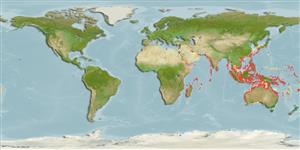Common names from other countries
Environment: milieu / climate zone / depth range / distribution range
Ecologia
Associadas(os) a recifes; intervalo de profundidade 0 - 45 m (Ref. 800). Tropical
Indo-West Pacific: Red Sea to New Caledonia and Japan.
Length at first maturity / Tamanho / Peso / Idade
Maturity: Lm ? range ? - ? cm
Inhabits sandy and rubble areas at depths of 0 to 45 m. Feeds on algae and small invertebrates. Associated with Allopontonia iaini, Periclimenes colemani and Leutzenia asthenosomae (commensals) (Ref. 800). Its movement is assisted by non-venomous spines on the underside of its test (Ref. 85384).
Life cycle and mating behavior
Maturidade | Reprodução | Desova | Ovos | Fecundidade | Larvas
Members of the class Echinoidea are gonochoric. Fertilization is external. Brooding is common, eggs are held either on the peristome, around the periproct or deep into the concavities on the petaloids. Life cycle: Embryos develop into planktotrophic larvae (echinoplateus) and live for several months before they sink to the bottom using their tube feet to adhere on the ground where they metamorphose into young urchins.
Schoppe, S. 2000. (Ref. 800)
Categoria na Lista Vermelha da IUCN (Ref. 130435)
Categoria CITES (Ref. 108899)
Not Evaluated
Not Evaluated
Ameaça para o homem
Venomous
Utilização humana
| FishSource |
Ferramentas
Mais informação
Idade/Tamanho
Crescimento
Comprimento-peso
Comprimento-comprimento
Morfologia
Larvas
Abundância
Fontes da internet
Estimates based on models
Preferred temperature
(Ref.
115969): 22.3 - 29, mean 27.8 (based on 1114 cells).
Categoria de preço
Unknown.
